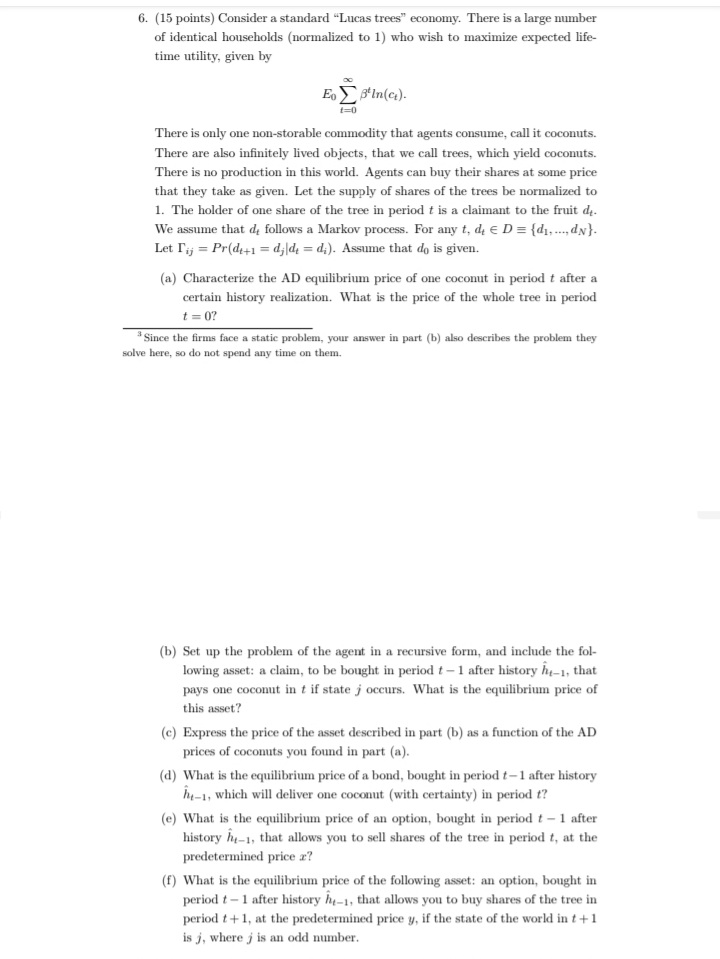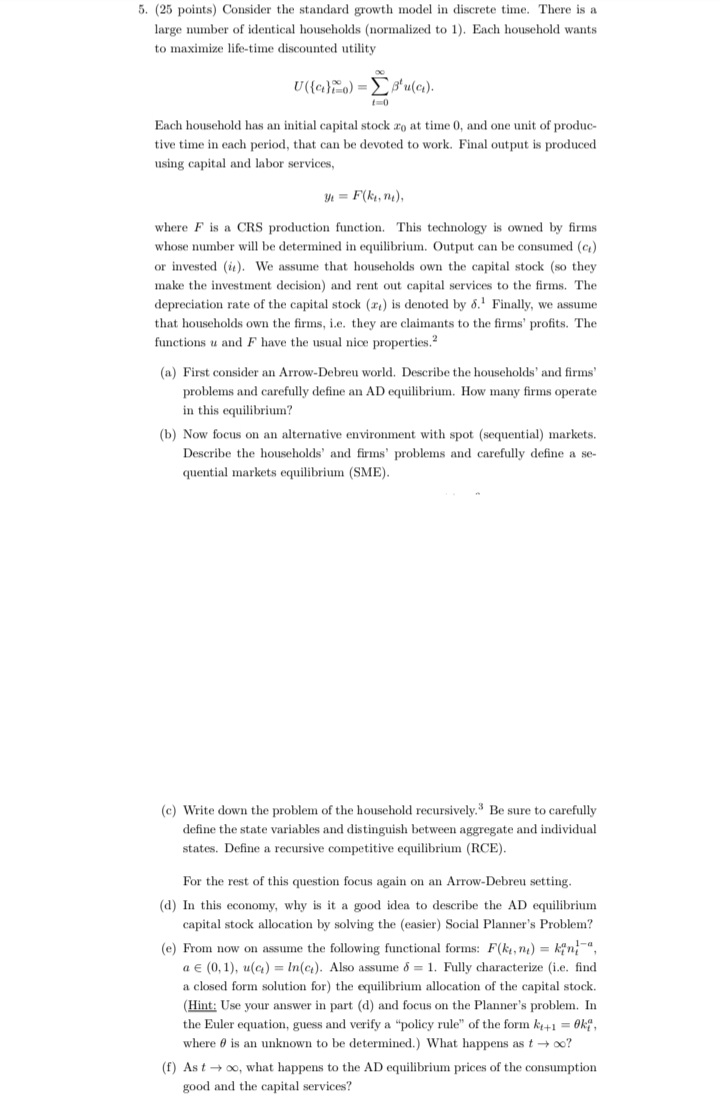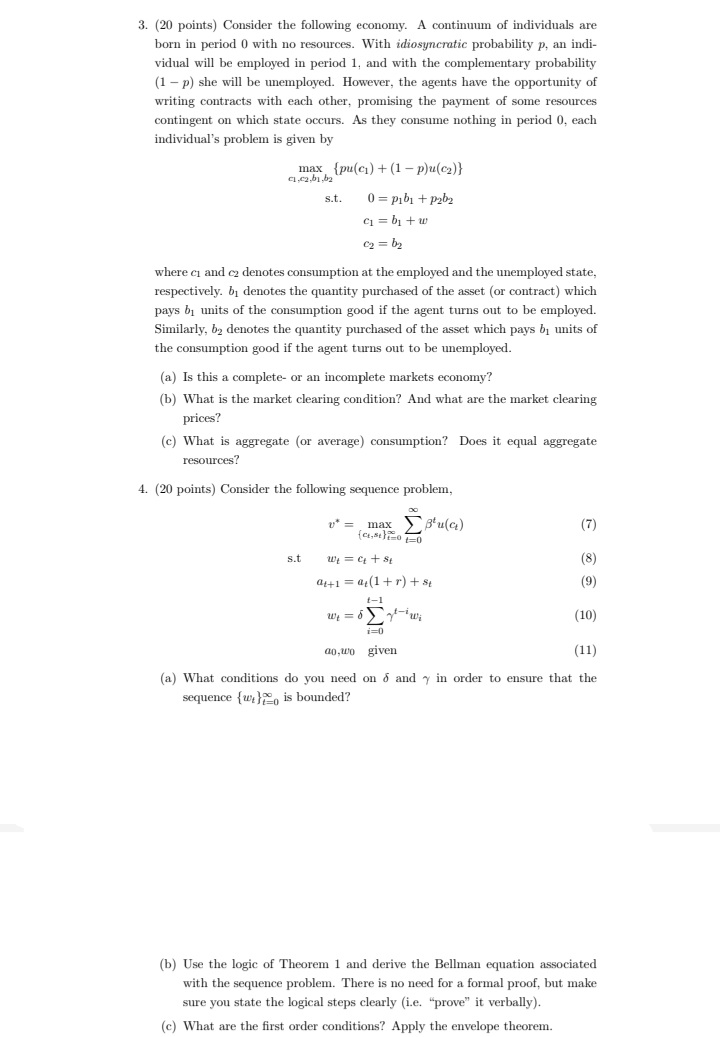



Solve and summarise the following questions thankyou
6. (15 points) Consider a standard "Lucas trees" economy. There is a large number of identical households (normalized to 1) who wish to maximize expected life- time utility, given by Eo B'In(c.). There is only one non-storable commodity that agents consume, call it coconuts. There are also infinitely lived objects, that we call trees, which yield coconuts. There is no production in this world. Agents can buy their shares at some price that they take as given. Let the supply of shares of the trees be normalized to 1. The holder of one share of the tree in period t is a claimant to the fruit de. We assume that de follows a Markov process. For any t, di E D = {d1, ..., dN}. Let lij = Pr(di+1 = djldt = d;). Assume that do is given. (a) Characterize the AD equilibrium price of one coconut in period t after a certain history realization. What is the price of the whole tree in period t = 07 Since the firms face a static problem, your answer in part (b) also describes the problem they solve here, so do not spend any time on them. (b) Set up the problem of the agent in a recursive form, and include the fol- lowing asset: a claim, to be bought in period t - 1 after history hy-1, that pays one coconut in t if state j occurs. What is the equilibrium price of this asset? (c) Express the price of the asset described in part (b) as a function of the AD prices of coconuts you found in part (a). (d) What is the equilibrium price of a bond, bought in period t-1 after history he-1, which will deliver one coconut (with certainty) in period t? (e) What is the equilibrium price of an option, bought in period t - 1 after history hy-1, that allows you to sell shares of the tree in period t, at the predetermined price z? (f) What is the equilibrium price of the following asset: an option, bought in period t - 1 after history he-1, that allows you to buy shares of the tree in period t + 1, at the predetermined price y, if the state of the world in t + 1 is j, where j is an odd number.5. (25 points) Consider the standard growth model in discrete time. There is a large number of identical households (normalized to 1). Each household wants to maximize life-time discounted utility U(q)io) = EB'u(c). Each household has an initial capital stock zo at time 0, and one unit of produc- tive time in each period, that can be devoted to work. Final output is produced using capital and labor services, UI = F(k, n.), where F is a CRS production function. This technology is owned by firms whose number will be determined in equilibrium. Output can be consumed (c) or invested (it). We assume that households own the capital stock (so they make the investment decision) and rent out capital services to the firms. The depreciation rate of the capital stock (r,) is denoted by 6. Finally, we assume that households own the firms, i.e. they are claimants to the firms' profits. The functions u and F have the usual nice properties." (a) First consider an Arrow-Debreu world. Describe the households' and firms' problems and carefully define an AD equilibrium. How many firms operate in this equilibrium? (b) Now focus on an alternative environment with spot (sequential) markets. Describe the households' and firms' problems and carefully define a se- quential markets equilibrium (SME). (c) Write down the problem of the household recursively." Be sure to carefully define the state variables and distinguish between aggregate and individual states. Define a recursive competitive equilibrium (RCE). For the rest of this question focus again on an Arrow-Debreu setting. (d) In this economy, why is it a good idea to describe the AD equilibrium capital stock allocation by solving the (easier) Social Planner's Problem? (e) From now on assume the following functional forms: F(k, n) = kin,-", a E (0, 1), u(c) = In(c). Also assume o = 1. Fully characterize (i.e. find a closed form solution for) the equilibrium allocation of the capital stock. (Hint: Use your answer in part (d) and focus on the Planner's problem. In the Euler equation, guess and verify a "policy rule" of the form kit = 0kf, where o is an unknown to be determined.) What happens as t -+ co? (f) As t -+ co, what happens to the AD equilibrium prices of the consumption good and the capital services?3. {20 points] lConsider the following economy. A continuum of individuals are born in period {1 with no resources. With idiosynefntr'c probability p, an indi- yidual will be employed in period 1, and with the complementary probability {1 p] she 1will be unemployed. However, the agents have the opportunity of writing contracts with each other, promising the payment of some resources contingent on which state occurs. As they consume nothing in period I], each individual's problem is given by qwml + {1 - pinion at [I = plhl +3125; c1 = in + w Ez=b2 where :1 and c: denotes consumption at the employed and the unemployed state, respectively. in denotes the quantity purchased of the asset [or contract] which pays ill units of the consumption good if the agent turns out to be employed. Similarly, b3 denotes the quantity purchased of the asset which pays ill units of the consumption good if the agent turns out to be unemployed. {a} Is this a complete- or an incomplete markets economy? {h} 1What is the market clearing condition? and what are the market clearing prices? [c] \"mat is aggregate [or average} consumption? Does it equal aggregate resources? 4. [2|] points] Consider the following sequence problem, n' = max 2 iuici] {T} {amigo I=IJ st 11!! = c, + s; {3] o5.\" = 1{1+1"l+31 l9] {1 111'! = I5 2 \"itiwi [ml :i=E| mom given [11] a'Whatconditinnsdnonne-edonuiand innrdertoensurethatthe 1' '3' sequence {wihmn is bounded'iI [h] Use the logic of Theorem 1 and derive the Bellman equation emaciated with the sequence problem. There is no need for a formal proof, but make sure you state the logical steps clearly [is "'prn'lil'e'I it verbally]. [c] 1What are the rst order conditions? Apply the envelope theorem. Part A: Questions on ECN 200D (Rendahl) 1. (5 points) Suppose that an agent will be employed in the next period with probability p. Symmetrically, the agent will remain unemployed with probabil- ity (1 - p). Suppose that an agent is unemployed in period 0. For how many periods can the agent expect to remain in unemployment (that is, what is her expected unemployment duration)? 2. (10 points) Consider the following Ramsey growth model augmented with a labor-leisure choice, and habits. max (1) s.t athit1 = f ( ke. ( ) (2) ko, C-14 60 given (3) In class, however, we often considered problems of the type max (4) s.t (5) To given (6) (a) Define at, F(, .) and I(.) such that these two problems coincide exactly. (b) What are the first order conditions to the problem in (1)-(3)? (c) What is the Bellman equation corresponding to the problem in (1)-(3)? (no proof needed)














